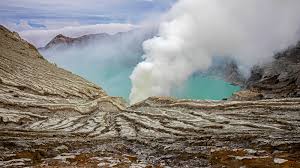A volcanic crater in Indonesia over 7,700 feet (2,350 meters) above sea level is home to Earth’s largest acidic lake, with water like battery acid. In this excerpt from “Beyond The Sea: The Hidden Life in Lakes, Streams, and Wetlands” (Johns Hopkins University Press, 2024), author David Strayer examines the extreme chemistry of some of our planet’s natural lakes — and the life they host.
I know people who really like water chemistry. They spend all day thinking about redox reactions and mass balance and valences and solubility indices and spiraling metrics, and when the workday is over, they go out for a beer with their friends and talk about redox reactions and spiraling metrics. (In my experience, water chemistry enthusiasts are often beer connoisseurs as well, which makes sense in a weird way if you think of a glass of beer as a special kind of aqueous solution.)
These are people who when asked to name their favorite chemical element say “ooh, ooh, can I have three?” and then name five. I’m guessing that you’re not one of those people.
So instead of going into great detail, element by tedious element, about the enormous variation in the chemical content of inland waters, I’m just going to briefly talk about how much pH varies across inland waters, assume that is sufficient to make my point about the chemical diversity of inland waters, and move on to subjects that you like better than water chemistry.
You may remember from high school chemistry that pH is a measure of whether a substance is acidic or basic (or “alkaline”). Materials that are neutral (neither acidic nor basic) have a pH of 7, acidic materials have a pH less than 7 (household vinegar has a pH of about 2.5), and basic materials have a pH greater than 7 (household ammonia has a pH of about 11.5).
The pH scale is logarithmic — a change in pH of one unit represents a 10-fold change in acidity (technically, a 10-fold change in the activity of hydrogen ions). So vinegar at a pH of 2.5 has about a billion times more hydrogen ion activity than does ammonia at a pH of 11.5.
The logarithmic scale allows us to conveniently express enormous differences in chemistry but makes it easy to forget that small differences on the pH scale can mean big differences in chemistry which can have large consequences.
For instance, the ocean today has a pH of around 8.1, which tells us that it is a little basic. Higher concentrations of carbon dioxide in the air resulting from fossil fuel burning have caused the ocean’s pH to fall 0.1 units from a preindustrial value of 8.2, and models suggest that it may fall to 7.8 by the year 2100.
These sound like small changes hardly worth worrying about. But a change from 8.2 to 8.1 represents an increase in hydrogen ion of 26%, and a change from 8.2 to 7.8 means an increase of 150%.
These changes are enough to cause serious problems for marine life. Organisms like clams and corals that make their shells out of calcium carbonate find it increasingly difficult to build and maintain their shells if the pH drops just a few tenths of a point. Ocean scientists are now scrambling to understand and find ways to prevent or manage these changes before we lose important parts of ocean ecosystems as the pH drops by 0.3 or 0.4 units.
The pH range across inland waters is far greater than the few tenths of a point that are so important in the ocean.
This exposes inland water organisms (and chemical processes) to an enormous range of chemical conditions. Most inland waters have a pH between 4 and 9. Again, this range may sound modest, but it represents a 100,000-fold range in hydrogen ion activity. And there are waters that lie outside even this expansive range.
The most acidic natural inland waters are the lakes that lie in the craters of volcanoes, like Kawah Ijen in Indonesia. These lakes are so rich in sulfuric acid that they may have a pH as low as 0.1. To put this in context, fresh battery acid has a pH of about 0.7.
The label on battery acid (which remember is about a quarter as strong as this lake water) warns that it causes severe skin burns and eye damage and advises consumers to use personal protective equipment, to immediately call a poison control center if it gets swallowed, and to dispose of it in an approved waste disposal plant. You might feel pretty confident in guessing that nothing lives in this lake.
But when scientists sampled Kawah Ijen (an undertaking that required special gear; as you might imagine, a lot of regular gear like aluminum boats would dissolve in the lake water), they found a green alga and three kinds of archaeans living in the lake.
Apparently, no animals live in the lake. However, the acid water in its outlet stream is gradually neutralized as it flows downstream, and the researchers discovered fly larvae called chironomids living in the stream at the point where the outlet stream reached a pH of about 2.5 (like vinegar, remember?).
